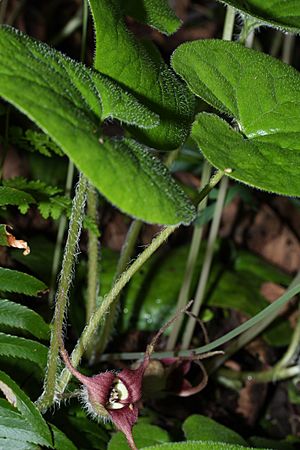Asarum facts for kids
Quick facts for kids Asarum |
|
|---|---|
 |
|
| Asarum caudatum (western wild ginger) | |
| Scientific classification |
|
| Kingdom: | Plantae |
| Clade: | Tracheophytes |
| Clade: | Angiosperms |
| Clade: | Magnoliids |
| Order: | Piperales |
| Family: | Aristolochiaceae |
| Subfamily: | Asaroideae |
| Genus: | Asarum L. |
| Type species | |
| Asarum europaeum |
|
| Species | |
|
See text |
|
Asarum is a group of plants often called wild ginger. It belongs to the Aristolochiaceae family, also known as the birthwort family.
The name Asarum comes from a Latin word meaning "altar" or "sanctuary."
About Wild Ginger
Wild ginger plants are usually low to the ground. They grow in cool areas of the Northern Hemisphere. Most types are found in East Asia (like China, Japan, and Vietnam) and North America. Only one type grows in Europe. Scientists believe Asarum first appeared in Asia.
These plants have special kidney-shaped leaves. They grow from rhizomes, which are stems that creep along or just under the ground. Their small flowers are brown or reddish and grow near where the leaves meet the stem.
The plant is called wild ginger because its underground stem (rhizome) smells and tastes a bit like real ginger. However, wild ginger is not closely related to the ginger you use for cooking. The U.S. Food and Drug Administration (FDA) warns people not to eat Asarum. It contains harmful chemicals that can damage your kidneys and may even cause cancer.
Wild ginger likes places that are damp and shady. It grows best in soil rich with humus, which is decayed plant and animal matter. Its heart-shaped leaves fall off in the autumn. Two new leaves grow each year from the tip of the rhizome. The interesting jug-shaped flowers appear in spring between the leaf bases. This is why the plant is sometimes called "little jug."
You can easily grow wild ginger in a shade garden. It makes a nice plant to cover the ground.

How Scientists Classify Wild Ginger
For a long time, scientists thought of Asarum as one large group with about 85 different types (species). But now, some plant scientists (botanists) prefer to divide the group into smaller, separate groups. They do this based on things like the number of chromosomes and the shape of the flowers.
Some of these smaller groups include:
- Asarum sensu stricto (meaning Asarum in the strict sense): This group has about 17 species. They are found in Asia (mostly China), North America, and Europe.
- Heterotropa: This group has about 50 species and grows in Asia.
- Asiasarum: This group has three or four species and is found in Asia.
- Geotaenium: This group also has three or four species and grows in Asia.
- Hexastylis: This group has ten species and is found in North America.
Newer studies, which look at plant DNA and physical features, suggest that it might be better to group Asarum into two main subgroups, each with two sections. Even with these new studies, many botanists still consider these smaller groups as part of the larger Asarum family.
Types of Wild Ginger
- Asarum arifolium
- Asarum asperum
- Asarum bashanense
- Asarum campaniflorum
- Asarum canadense
- Asarum caudatum
- Asarum caudigerellum
- Asarum caudigerum
- Asarum caulescens
- Asarum chengkouense
- Asarum chinensis
- Asarum controversum
- Asarum crassisepalum
- Asarum crassum
- Asarum crispulatum
- Asarum debile
- Asarum delavayi
- Asarum dimidiatum (also known as Asiasarum dimidiatum)
- Asarum epigynum (also known as Geotaenium epigynum)
- Asarum europaeum
- Asarum forbesii (also known as Heterotropa forbesii)
- Asarum fukienense
- Asarum geophilum (also known as Geotaenium geophilum)
- Asarum gusuk
- Asarum hartwegii
- Asarum hayatanum
- Asarum heterotropoides (also known as Asiasarum heterotropoides)
- Asarum himalaicum
- Asarum hongkongense
- Asarum hypogynum
- Asarum ichangense
- Asarum inflatum
- Asarum insignis
- Asarum kooyanum
- Asarum lemmonii
- Asarum leptophyllum
- Asarum longerhizomatosum
- Asarum macranthum
- Asarum magnificum
- Asarum majale
- Asarum marmoratum
- Asarum maruyamae
- Asarum maximum
- Asarum mikuniense
- Asarum mitoanum
- Asarum nanchuanense
- Asarum nobilissimum
- Asarum petelotii
- Asarum porphyronotum
- Asarum pulchellum
- Asarum renicordatum
- Asarum rosei
- Asarum sagittarioides
- Asarum senkakuinsulare
- Asarum sieboldii (also known as Asiasarum sieboldii)
- Asarum splendens
- Asarum taipingshanianum
- Asarum tohokuense
- Asarum tongjiangense
- Asarum wagneri
- Asarum wulingense
- Asarum yunnanense (also known as Geotaenium yunnanse)
Uses
Even though wild ginger smells like cooking ginger, it is not safe to eat. It contains chemicals that can be very harmful to your body. Historically, some types were used in traditional medicine, but due to their dangerous properties, they are not recommended for use.
See also
 In Spanish: Jengibre salvaje para niños
In Spanish: Jengibre salvaje para niños

